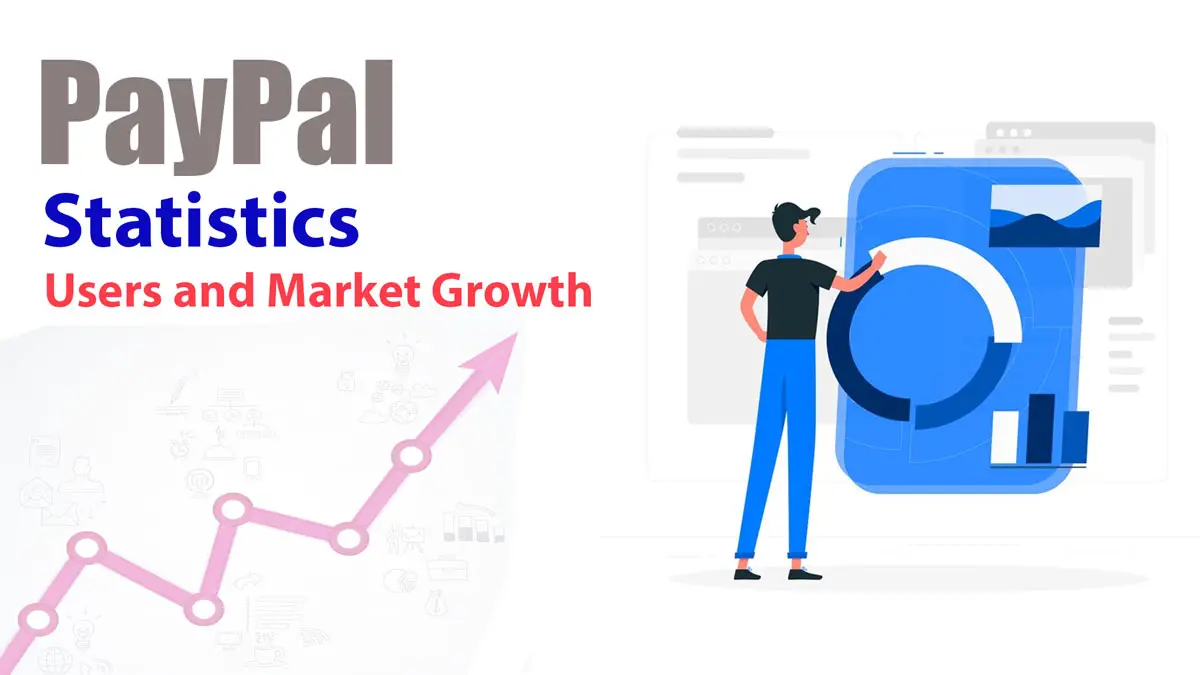PayPal Statistics 2025: Unveiling the Dominance of a Digital Payment Giant
In the ever-evolving landscape of digital payments, one name consistently reigns supreme: PayPal. As we approach 2025, understanding the scope of PayPal’s influence is crucial for businesses, consumers, and anyone involved in the digital economy.
This comprehensive analysis delves into the latest PayPal statistics, dissecting its user base, market share, transaction volumes, revenue streams, and future projections. Prepare to uncover the data-driven insights that solidify PayPal’s position as a global leader in online payments.
The Reign Continues: PayPal’s Unwavering Dominance
PayPal’s position in the digital payment realm is nothing short of formidable. In the first three quarters of 2024 alone, the platform processed a staggering 19.72 billion transactions, a figure that surpasses some of its full-year totals from previous years.
This robust performance underscores the platform’s continued relevance and increasing adoption in the digital age.
Beyond transaction volume, PayPal boasts a commanding 45.52% market share, dwarfing its competitors such as Stripe (17.15%) and Shopify Pay Installments (15.68%). This dominance is further reinforced by its massive active user base, which currently stands at 432 million worldwide. This extensive network of users makes PayPal the preferred choice for countless online shoppers and businesses alike.
Key Highlights: PayPal Statistics at a Glance
Before we delve deeper into the data, here’s a snapshot of the most compelling PayPal statistics for 2025:
- Global User Base: 432 million people worldwide actively utilize PayPal for their digital payment needs.
- Market Leadership: With a 45.52% market share, PayPal remains the undisputed leader in the payment processing industry.
- US Dominance: The United States boasts the largest concentration of PayPal users, with an impressive 278.1 million accounts.
- Business Powerhouse: Over 30 million businesses globally rely on PayPal to facilitate seamless transactions.
- Global Workforce: PayPal employs a substantial workforce of over 27,200 individuals worldwide.
Decoding the User Base: How Many People Use PayPal?
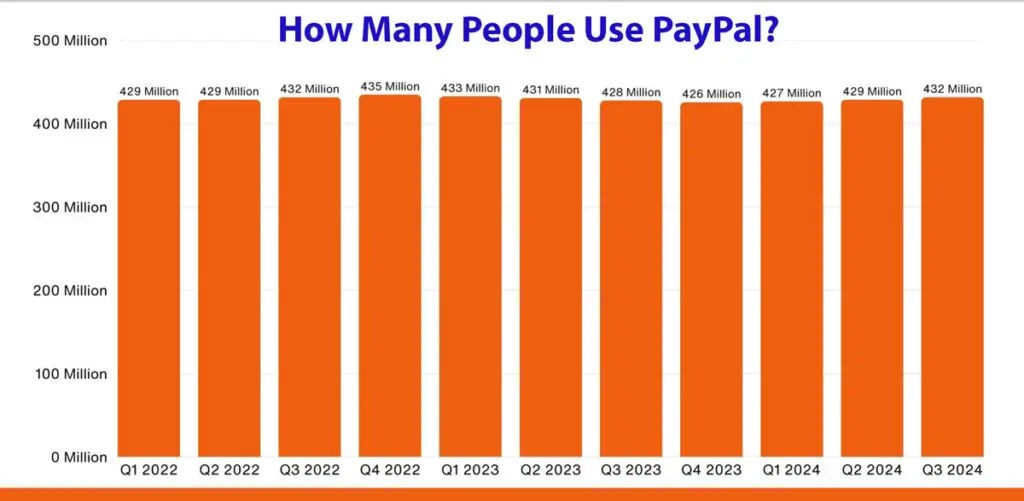
As of the latest data, PayPal boasts a global user base of approximately 432 million active accounts.
While this represents a modest 0.9% increase compared to the previous year, a closer examination reveals a steady upward trend. Since the first quarter of 2024, the platform has added roughly 5 million new users, demonstrating its ongoing ability to attract and retain customers.
Looking back at the end of 2023, PayPal reported a total of 426 million users, further emphasizing the platform’s consistent growth trajectory. This expansion is fueled by several factors, including the increasing popularity of online shopping, the convenience of digital payments, and PayPal’s reputation for security and reliability.
Quarterly User Growth: A Detailed Breakdown
To gain a more granular understanding of PayPal’s user growth, let’s examine the quarterly data:
| Quarter | PayPal Active Accounts |
|---|---|
| Q3 2024 | 432 million |
| Q2 2024 | 429 million |
| Q1 2024 | 427 million |
| Q4 2023 | 426 million |
| Q3 2023 | 428 million |
| Q2 2023 | 431 million |
| Q1 2023 | 433 million |
| Q4 2022 | 435 million |
| Q3 2022 | 432 million |
| Q2 2022 | 429 million |
| Q1 2022 | 429 million |
This quarterly breakdown reveals a pattern of consistent user acquisition, highlighting PayPal’s ability to maintain its growth momentum in a competitive market.
Geographic Distribution: Where Are PayPal Users Located?

While PayPal’s reach extends across the globe, certain countries stand out in terms of user concentration. The United States leads the pack with a remarkable 278.1 million users, solidifying its position as PayPal’s most important market.
Following closely behind is Germany, with an impressive 137.7 million users, securing the second spot in terms of user base. The United Kingdom ranks third, with 56.2 million users, further demonstrating PayPal’s strong presence in Europe. Italy and France also feature among the top five countries with the highest number of PayPal users, highlighting the platform’s widespread adoption across the continent.
PayPal Users by Country: A Comparative Analysis
| Country | Number of PayPal Users |
|---|---|
| United States | 278.1 million |
| Germany | 137.7 million |
| United Kingdom | 56.2 million |
| Italy | 21.9 million |
| France | 20.5 million |
This geographic distribution underscores PayPal’s global appeal and its ability to cater to diverse markets with varying payment preferences.
Market Share Dynamics: PayPal vs. the Competition
As previously mentioned, PayPal dominates the payment processing market with a commanding 45.52% market share. This figure highlights the platform’s significant lead over its competitors and its entrenched position in the industry.
Stripe emerges as PayPal’s closest competitor, holding a 17.15% market share. While Stripe has made significant strides in recent years, it still lags considerably behind PayPal in terms of overall market dominance. Shopify Pay Installments secures the third spot with a 15.68% market share, demonstrating the growing popularity of buy-now-pay-later options.
Payment Processing Market Share: A Competitive Landscape
| Company Name | Market Share |
|---|---|
| PayPal | 45.52% |
| Stripe | 17.15% |
| Shopify Pay Installments | 15.68% |
| Amazon Pay | 2.62% |
| SecurePay | 1.5% |
| PayPal Braintree | 1.2% |
| Stripe Checkout | 1.18% |
| Afterpay | 1.12% |
This market share breakdown illustrates the competitive dynamics of the payment processing industry, with PayPal maintaining a significant lead over its rivals.
Understanding the User Demographics: Who Uses PayPal?
To gain a deeper understanding of PayPal’s user base, it’s essential to analyze its demographics. According to recent data, 56% of Americans report having a PayPal account, highlighting the platform’s widespread adoption in the United States.
In the United Kingdom, approximately 2 million individuals claim to have a PayPal account, further underscoring the platform’s popularity in Europe. Moreover, 75% of Europeans express greater trust in PayPal compared to other payment services, indicating a strong level of confidence in the platform’s security and reliability.
Interestingly, children constitute up to 9% of PayPal users in the United States, suggesting that parents are increasingly using the platform to manage their children’s online spending. Furthermore, 85% of Gen X online consumers in the United States have reported using PayPal at some point, highlighting the platform’s long-standing appeal across different generations.
Millennials represent a significant portion of PayPal’s user base, accounting for an impressive 97% of users worldwide. Within this demographic, 25% of PayPal users are aged between 25 and 34, while 19% are aged between 35 and 44. The remaining 14% are below the age of 24, indicating that PayPal is attracting a younger generation of digital natives.
PayPal’s Financial Performance: Revenue and Profitability
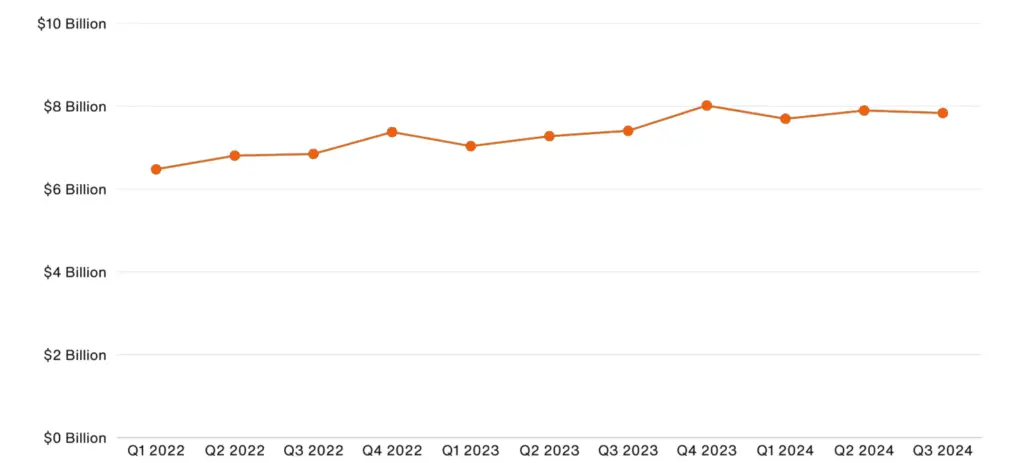
In the first three quarters of 2024, PayPal generated a substantial $23.4 billion in revenue, demonstrating its continued financial strength. This figure is broken down into $7.7 billion in Q1, $7.9 billion in Q2, and $7.8 billion in Q3, indicating consistent revenue generation throughout the year.
For the full year 2023, PayPal reported a total revenue of $29.77 billion, reflecting an impressive 8.19% year-over-year increase. This growth is driven by factors such as increased transaction volume, expanding user base, and the introduction of new services and features.
PayPal Revenue by Year: A Historical Perspective
| Quarter | Revenue Generated | Year-on-year Percentage |
|---|---|---|
| Q3 2024 | $7.84 billion | 6% |
| Q2 2024 | $7.9 billion | 8% |
| Q1 2024 | $7.7 billion | 9% |
| Q4 2023 | $8.02 billion | 8.67% |
| Q3 2023 | $7.41 billion | 8.33% |
| Q2 2023 | $7.28 billion | 7.05% |
| Q1 2023 | $7.04 billion | 8.6% |
| Q4 2022 | $7.38 billion | 6.7% |
| Q3 2022 | $6.85 billion | 10.7% |
| Q2 2022 | $6.81 billion | 9.1% |
| Q1 2022 | $6.48 billion | 7.5% |
This historical data highlights PayPal’s consistent revenue growth over the years, demonstrating its ability to adapt to changing market conditions and maintain its financial strength.
Profitability Analysis: Net Income and Net Loss
In the third quarter of 2024, PayPal reported a net income of $1.01 billion, indicating its continued profitability. However, this figure represents a 1% decline compared to the same period last year and a decrease of over $118 million from the previous quarter.
PayPal’s Net Income (Loss) by Quarter: A Detailed View
| Quarter | Net Income (loss) | Year-on-year Percentage Change |
|---|---|---|
| Q3 2024 | $1,010 million | -1% |
| Q2 2024 | $1,128 million | 10% |
| Q1 2024 | $888 million | 12% |
| Q4 2023 | $1,402 million | 52.22% |
| Q3 2023 | $1,020 million | -23.3% |
| Q2 2023 | $1,029 million | 401.8% |
| Q1 2023 | $795 million | 56.2% |
| Q4 2022 | $921 million | 15% |
| Q3 2022 | $1,330 million | 4% |
| Q2 2022 | – $341 million | -128.8% |
| Q1 2022 | $509 million | -53.6% |
This data provides a comprehensive overview of PayPal’s profitability, highlighting both its successes and challenges in a dynamic market.
Merchant Adoption: PayPal’s Role in Business Transactions
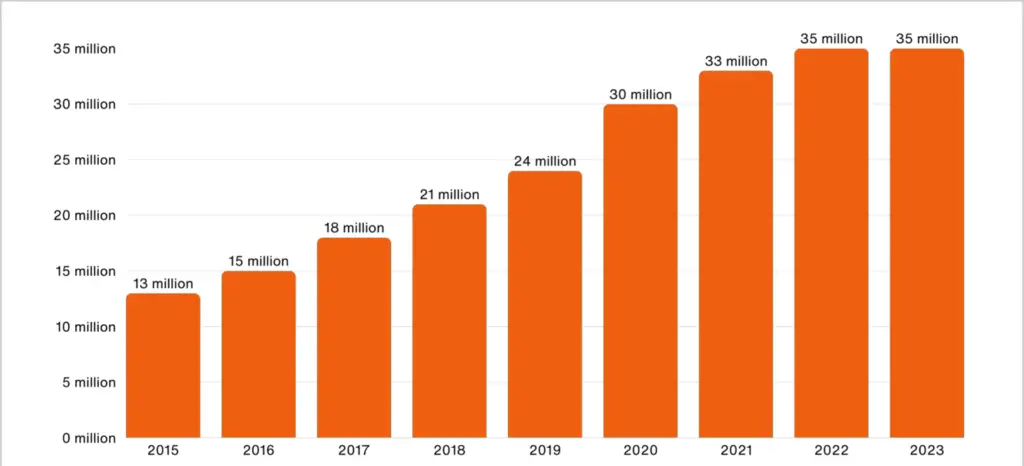
PayPal has become an indispensable tool for businesses of all sizes, with over 35 million merchant accounts currently active. This figure represents a significant increase of 5 million since 2020, demonstrating the platform’s growing appeal among merchants.
PayPal Merchant Accounts: A Growing Trend
| Year | Account |
|---|---|
| 2023 | 35 million |
| 2022 | 35 million |
| 2021 | 33 million |
| 2020 | 30 million |
| 2019 | 24 million |
| 2018 | 21 million |
| 2017 | 18 million |
| 2016 | 15 million |
| 2015 | 13 million |
This data underscores PayPal’s crucial role in facilitating online commerce and its importance to businesses seeking to reach a global customer base.
Global Reach: PayPal’s Availability Across Borders
PayPal’s availability spans over 200 countries and regions worldwide, making it one of the most widely accepted payment options globally. This extensive reach allows businesses to seamlessly transact with customers across borders, expanding their market potential.
Furthermore, PayPal supports 25 major currencies, including the US dollar and Japanese yen, enabling seamless global transactions without the hassle of currency conversion.
Transaction Volume: A Measure of PayPal’s Activity
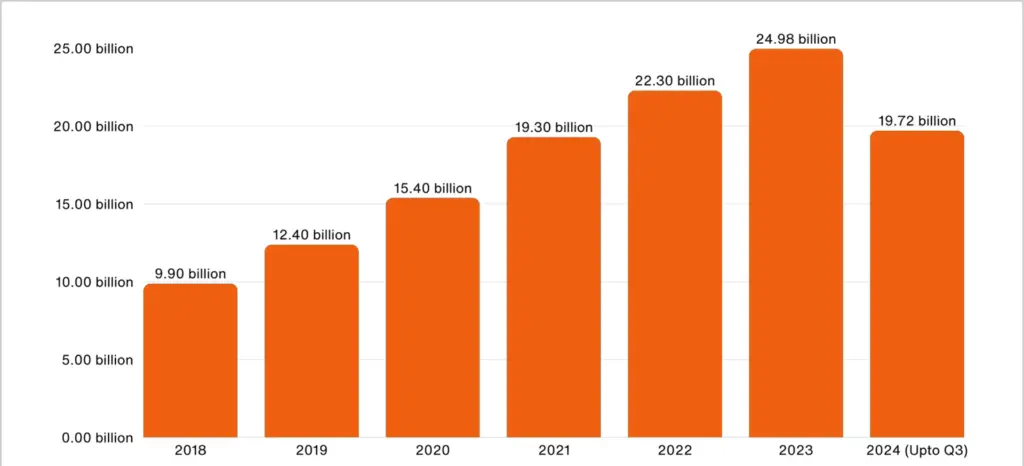
In the first three quarters of 2024 alone, PayPal processed an impressive 19.72 billion transactions, surpassing the total for all of 2021 (19.3 billion).
This robust performance highlights the platform’s increasing activity and its importance in the digital economy.
PayPal achieved its highest transaction volume in 2023, reaching a staggering 24.98 billion transactions. This figure represents a significant increase from previous years, underscoring the platform’s rapid growth and increasing global usage.
PayPal Transaction Volume: A Historical Perspective
| Year | Number of PayPal Transactions |
|---|---|
| 2024 (Upto Q3) | 19.72 billion |
| 2023 | 24.98 billion |
| 2022 | 22.3 billion |
| 2021 | 19.3 billion |
| 2020 | 15.4 billion |
| 2019 | 12.4 billion |
| 2018 | 9.9 billion |
This historical data illustrates PayPal’s remarkable growth in transaction volume, highlighting its increasing adoption and its role in facilitating digital commerce.
Transaction Frequency: How Often Do People Use PayPal?
PayPal recorded an average of 58.7 transactions per account in 2023, representing a significant 13% increase compared to the previous year. This indicates that users are increasingly relying on PayPal for their everyday transactions.
PayPal Payment Transactions Per Account: A Growing Trend
| Year | Transaction Per Account |
|---|---|
| 2023 | 58.7 |
| 2022 | 51 |
| 2021 | 45 |
| 2020 | 40 |
| 2019 | 40 |
| 2018 | 36 |
| 2017 | 33 |
| 2016 | 31 |
This data demonstrates the increasing frequency with which users are engaging with PayPal, solidifying its position as a preferred payment method.
Workforce Dynamics: PayPal’s Employee Base
PayPal employs a substantial workforce of over 27,200 individuals worldwide, reflecting its significant scale of operations. While the number of employees decreased in 2022 due to layoffs, the company continues to maintain a large global workforce to support its diverse range of services.
PayPal Employees: A Historical Overview
| Year | Number of PayPal Employees |
|---|---|
| 2023 | 27,200 |
| 2022 | 29,900 |
| 2021 | 30,900 |
| 2020 | 26,500 |
| 2019 | 23,200 |
| 2018 | 21,800 |
| 2017 | 18,700 |
This data provides insights into PayPal’s workforce trends, highlighting its commitment to employing a skilled and dedicated team.
Consumer Behavior: How Consumers Interact with PayPal
Consumers have indicated that they are 54% more likely to make an online purchase if the merchant accepts PayPal, highlighting the platform’s influence on purchasing decisions. The average PayPal balance of an American consumer is reported to be $485, suggesting that users are actively storing funds within their PayPal accounts.
Interestingly, 66% of PayPal consumers report that they primarily shop from domestic merchants, indicating a preference for supporting local businesses. Furthermore, 65% of mobile devices with mobile payment apps have PayPal installed, highlighting the platform’s widespread adoption on mobile devices.
Cross-border purchases on PayPal are particularly prominent in China, accounting for 26% of all international transactions.
Strategic Acquisitions: Expanding PayPal’s Capabilities
Over the past decade, PayPal has strategically acquired several companies to expand its range of financial services and cater to the evolving needs of its customers and merchants. Some key acquisitions include:
| Year | Acquisitions |
|---|---|
| 2008 | Fraud Sciences, Bill Me Later |
| 2011 | Where.com, FigCard, Zong |
| 2012 | card.io |
| 2013 | IronPearl, Braintree, Venmo, StackMob |
| 2015 | Paydiant, CyActive, Xoom Corporation, Modest Inc |
| 2017 | TIO Networks, Swift Financial |
| 2018 | Jetlore, iZettle, Hyperwallet, Simility |
| 2019 | GoPay, Honey |
| 2021 | 2021, Chargehound, Happy Returns, Paidy |
One of PayPal’s most significant acquisitions was Honey, acquired for $4 billion in 2019. Honey is a popular platform that helps people shop online and discover the best deals, while also earning cashback rewards. Users have reportedly saved over $1 billion using Honey, highlighting its value proposition.
PayPal’s Top Acquisitions: A Financial Overview
| Acquisition | Price |
|---|---|
| Honey | $4 billion |
| Braintree | $800 million |
| Xoom | $800 million |
| iZettle | $2.2 billion |
These strategic acquisitions have enabled PayPal to expand its service offerings, enhance its technological capabilities, and strengthen its competitive position in the market.
Addressing Fraud: PayPal’s Ongoing Efforts
While PayPal has implemented robust security measures, fraud remains a concern for any online payment platform. PayPal’s fraud rate is estimated to be between 0.17 and 0.18 percent of its revenue, representing a loss of more than $1 billion annually.
The Future of PayPal: Trends and Projections
As we look towards 2025 and beyond, PayPal is poised to continue its dominance in the digital payment landscape. Several key trends are expected to shape the company’s future:
- Continued Growth in E-commerce: The ongoing growth of e-commerce will continue to drive demand for digital payment solutions, benefiting PayPal.
- Expansion into New Markets: PayPal is likely to expand its presence in emerging markets, tapping into new user bases and revenue streams.
- Focus on Mobile Payments: With the increasing adoption of mobile devices, PayPal will likely prioritize its mobile payment offerings to cater to on-the-go consumers.
- Integration of New Technologies: PayPal will likely integrate new technologies such as blockchain and cryptocurrency to enhance its security and efficiency.
- Emphasis on Security and Fraud Prevention: As fraud continues to be a concern, PayPal will likely invest in advanced security measures to protect its users and merchants.
PayPal Statistics 2025: A Deeper Dive into the Payment Processing Giant (Extended Analysis)
While the previous overview established PayPal’s dominance in the digital payment landscape, a deeper examination reveals more nuanced insights into its operations, challenges, and future prospects. This extended analysis delves into specific areas, including:
- PayPal’s Competitive Strategies: How PayPal maintains its lead in a rapidly evolving market.
- Innovation and Technological Advancements: PayPal’s investment in cutting-edge technologies to enhance its services.
- Addressing Security Concerns and Fraud Prevention: A detailed look at PayPal’s efforts to combat fraud and maintain user trust.
- The Rise of Alternative Payment Methods: How PayPal is adapting to the growing popularity of buy-now-pay-later and cryptocurrency options.
- PayPal’s Impact on Small Businesses: Examining the role of PayPal in empowering small businesses and facilitating their growth.
- Future Projections and Potential Disruptions: Forecasting PayPal’s future and identifying potential challenges to its dominance.
Competitive Strategies: Maintaining the Lead in a Dynamic Market
PayPal’s success is not merely a result of its early entry into the market. The company has consistently adopted strategic initiatives to maintain its competitive edge, including:
- Building a Trusted Brand: PayPal has cultivated a strong reputation for security, reliability, and user-friendliness, fostering customer loyalty and trust.
- Expanding Service Offerings: Beyond basic payment processing, PayPal offers a range of services, including invoicing, merchant financing, and cross-border payments, catering to diverse customer needs.
- Strategic Partnerships: PayPal collaborates with major e-commerce platforms, banks, and other financial institutions to expand its reach and integrate its services into various ecosystems.
- Acquiring Innovative Companies: As highlighted earlier, PayPal strategically acquires companies with innovative technologies and capabilities to enhance its service offerings and stay ahead of the competition.
- Investing in Customer Experience: PayPal continuously invests in improving its user interface, customer support, and overall customer experience to enhance user satisfaction and retention.
Innovation and Technological Advancements: Embracing the Future of Payments
PayPal recognizes the importance of innovation in the rapidly evolving digital payment landscape. The company is actively investing in cutting-edge technologies to enhance its services and stay ahead of the curve:
- Blockchain Technology: PayPal is exploring the potential of blockchain technology to enhance the security, transparency, and efficiency of its payment processing systems.
- Cryptocurrency Integration: PayPal has already taken steps to integrate cryptocurrencies into its platform, allowing users to buy, sell, and hold cryptocurrencies through their PayPal accounts.
- Artificial Intelligence (AI): PayPal leverages AI to detect and prevent fraud, personalize customer experiences, and automate various operational processes.
- Biometric Authentication: PayPal is exploring biometric authentication methods, such as fingerprint and facial recognition, to enhance security and streamline the login process.
- Mobile Payments: PayPal is heavily invested in mobile payment solutions, including its mobile app and integration with mobile wallets, to cater to the growing number of consumers who prefer to pay with their smartphones.
Addressing Security Concerns and Fraud Prevention: Safeguarding User Trust
Security and fraud prevention are paramount concerns for any digital payment platform. PayPal has implemented a multi-layered security approach to protect its users and merchants from fraudulent activities:
- Advanced Encryption Technology: PayPal utilizes advanced encryption technology to protect sensitive financial data during transmission and storage.
- Fraud Detection Systems: PayPal employs sophisticated fraud detection systems that analyze transaction patterns and identify suspicious activities in real-time.
- Account Monitoring and Verification: PayPal actively monitors accounts for suspicious behavior and employs rigorous verification processes to prevent unauthorized access.
- Dispute Resolution Mechanisms: PayPal provides dispute resolution mechanisms to help buyers and sellers resolve disputes fairly and efficiently.
- Security Awareness Education: PayPal educates its users about security best practices to help them protect themselves from phishing scams and other fraudulent activities.
The Rise of Alternative Payment Methods: Adapting to Changing Preferences
While PayPal remains the dominant player, alternative payment methods such as buy-now-pay-later (BNPL) and cryptocurrencies are gaining traction. PayPal is adapting to these trends by:
- Offering BNPL Options: PayPal has introduced its own BNPL service, allowing users to split purchases into smaller installments, competing with companies like Afterpay and Klarna.
- Integrating Cryptocurrency Support: As mentioned earlier, PayPal allows users to buy, sell, and hold cryptocurrencies through its platform, embracing the growing popularity of digital currencies.
- Expanding Payment Options: PayPal continues to expand its range of payment options to cater to diverse customer preferences, including credit cards, debit cards, and bank transfers.
PayPal’s Impact on Small Businesses: Empowering Growth and Expansion
PayPal plays a crucial role in empowering small businesses and facilitating their growth by:
- Providing Access to a Global Customer Base: PayPal allows small businesses to reach customers worldwide, expanding their market potential beyond local boundaries.
- Simplifying Payment Processing: PayPal simplifies the payment processing process, allowing small businesses to easily accept online payments without the need for complex merchant accounts.
- Offering Financing Options: PayPal offers financing options to help small businesses manage their cash flow and invest in growth opportunities.
- Providing Marketing and Analytics Tools: PayPal provides marketing and analytics tools to help small businesses track their performance, understand their customers, and optimize their marketing campaigns.
- Building Trust and Credibility: Accepting PayPal payments can enhance a small business’s credibility and build trust with customers, particularly those who are unfamiliar with the brand.
Future Projections and Potential Disruptions: Navigating the Challenges Ahead
While PayPal is well-positioned for continued success, the company faces several potential challenges and disruptions:
- Increased Competition: The digital payment landscape is becoming increasingly competitive, with new players entering the market and existing competitors expanding their offerings.
- Regulatory Scrutiny: PayPal faces increasing regulatory scrutiny from governments and financial institutions, particularly regarding data privacy and anti-money laundering compliance.
- Technological Disruption: Emerging technologies such as decentralized finance (DeFi) and blockchain-based payment systems could potentially disrupt traditional payment models and challenge PayPal’s dominance.
- Cybersecurity Threats: The increasing sophistication of cyberattacks poses a constant threat to PayPal’s security and requires ongoing investment in fraud prevention and cybersecurity measures.
- Changing Consumer Preferences: Shifting consumer preferences and the emergence of new payment methods could require PayPal to adapt its offerings and strategies to remain relevant.
Conclusion: PayPal’s Enduring Legacy in the Digital Payment World
With a staggering 432 million users and a commanding 45.52% market share, PayPal stands as the undisputed leader in the digital payment landscape. In the first three quarters of 2024 alone, the platform processed 19.72 billion transactions, highlighting its continued growth and relevance.
With over 30 million businesses relying on PayPal and 278.1 million users in the United States, its influence in the digital payment ecosystem is undeniable. Operating in over 200 countries and regions, PayPal continues to expand its reach, solidifying its position as a global payment giant.
As online payments continue to evolve, PayPal remains at the forefront, shaping the future of digital transactions and empowering businesses and consumers alike.

